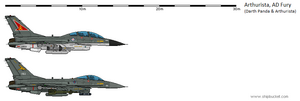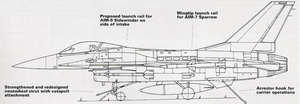Arthuristan Dynamics Fury: Difference between revisions
Arthurista (talk | contribs) m (→Fury FGR.2) |
Arthurista (talk | contribs) m (→Design) |
||
| Line 36: | Line 36: | ||
[[File:Arthuristan Dynamics Fury sea strike.png|thumb|right|300px|The Fury is capable of carrying up to four anti-ship missiles]] | [[File:Arthuristan Dynamics Fury sea strike.png|thumb|right|300px|The Fury is capable of carrying up to four anti-ship missiles]] | ||
The first configuration of the aircraft, the '''Fury FG.1''', was equipped with a [[Blue Courser]] pulse doppler multi-function radar with considerable look-down/shoot-down and track-while-scan capabilities, enabling it to carry beyond-visual range missiles such as the {{Wp|Sky Flash}}. It also has ground-mapping and sea-search capabilities which enables it to launch long-range anti-ship weapons such as the [[ACM-2 Renove]]. | The first configuration of the aircraft, the '''Fury FG.1''', was equipped with a [[Blue Courser]] pulse doppler multi-function radar with considerable look-down/shoot-down and track-while-scan capabilities, enabling it to carry beyond-visual range missiles such as the {{Wp|Sky Flash}}. It also has ground-mapping and sea-search capabilities which enables it to launch long-range anti-ship weapons such as the [[ACM-2 Renove]]. | ||
The Fury was the first Arthuristan fighter aircraft to feature a number of important innovations, including fly-by-wire control and glass-cockpit. | |||
===Fury FG.1=== | ===Fury FG.1=== | ||
Revision as of 04:06, 31 December 2019
| Arthuristan Dynamics Fury | |
|---|---|

| |
| Fleet Air Arm Sea Furies | |
| Role | Multi-role fighter bomber |
| Manufacturer | Arthuristan Dynamics |
| First flight | 1975 |
| Introduction | 1978 |
| Status | In service |
| Primary user | Fleet Air Arm, Commonwealth Air Force |
The Arthuristan Dynamics Fury and the navalised Sea Fury are a family of multi-role fighter bombers in service with the Arthuristan Fleet Air Arm and Commonwealth Air Force. Although slated to be replaced by the UFC Tempest, significant numbers remain in service.
Origins
Arthurista's flying services were concerned with the replacement of three models of combat aircraft in the 1970's. At the time, the Belfrasian Continental Reaper filled the niche of heavy air superiority fighter, the Arthuristan Dynamics Mercury served as a long-range heavy strike aircraft, whilst the Greenwich Super Tigress was the primary light fighter and ground attack platform. Due to the relatively benign defence environment at the time, the right wing National Liberal Party wished to relieve some budgetary pressure by forcing the military to 'neck down' from three different models to one aircraft capable of performing all their roles.
This led to considerable protests among the services, and the decision would later be reversed when a new Labour government, primarily concerned with the conservation of jobs in the Arthuristan aviation industry, was elected in 1973. Under the new government, the Arthuristan Dynamics Cyclone was procured, and work began to develop the STOVL Arthuristan Dynamics Kestrel. However, the niche defined for the Fury remained, and considerable development work had already been completed. The aircraft was successfully prototyped and entered production in the late-1970's.
Design
Compared with its diminuitive prototype, the Fury features a measurably larger airframe, which is about 1m longer and possesses a wing area which is roughly 23% larger, allowing it to carry additional fuel. The navalised Sea Fury is designed to be resistant to salt-water corrosion and has a robustified undercarriage and airframe designed to withstand the stress of catapult launch and arrestor-wire landings. In order to counteract the weight gain, a more powerful turbofan engine is installed. Able to develop 75kn of thrust 'dry' and 130kn with afterburner, it was upon its introduction the most powerful single-engined fighter in the world.
The large airframe and powerful engine enable the Fury to have a considerable combat radius. When equipped solely with air-to-air ordnance and drop tanks, it has an air interception range of more than 1,200km, whilst naval strike range with two drop tanks, two air-to-air missiles and four ACM-2 Renove or ACM-13 Lilith is around 833km.
The first configuration of the aircraft, the Fury FG.1, was equipped with a Blue Courser pulse doppler multi-function radar with considerable look-down/shoot-down and track-while-scan capabilities, enabling it to carry beyond-visual range missiles such as the Sky Flash. It also has ground-mapping and sea-search capabilities which enables it to launch long-range anti-ship weapons such as the ACM-2 Renove.
The Fury was the first Arthuristan fighter aircraft to feature a number of important innovations, including fly-by-wire control and glass-cockpit.
Fury FG.1
The Fury FG.1+ upgrade of the late-80's incorporates the Belfrasian LANTIRN navigation and targeting pods, which allows the Fury to perform precision-strikes at tree-top altitude in all weather conditions with laser- and electro-optical guided munitions. This enabled the Fury to fully replace the Arthuristan Dynamics Mercury as Arthurista's prime strike aircraft, despite the Fury's inferiority in combat radius.
Fury FGR.2
The FGR.2 of the early-1990's incorporates the Blue Vixen radar installed on later variants of the Sea Kestrel, as well as IRST and helmet-mounted display. This aircraft is compatible with new generations of air-to-air missiles such as the AIM-120 AMRAAM and the Python-4, as well as the whole gamut of modern precision-guided munitions. The FGR.2+ replaces the LANTIRN's targeting pod with the more advanced Litening, although the navigation pod is retained.
The aircraft's electronic warfare and countermeasures systems were also extensively overhauled to operate as an integrated, automated suite, rather than discrete elements operating simultaneously but independently. It features a new radar-warning receiver, pod-mounted jammers, as well as towed decoy, whilst retaining the original flare/chaff dispenser equipment.
The FGR.1E and the FGR.2E were Commonwealth Air Force aircraft given an 'upgrade kit' in order to optimise them for the SEAD role. They feature the Mark 7V advanced radar warning receiver, which is mounted in place of the cannon. This unit is capable of automatically detecting, processing and prioritising hostile radar signals, and providing fire control for anti-radiation missiles. Aside from the loss of the cannon, these aircraft remain the air combat and ground strike capabilities of the baseline Fury. They are intended to fill the gap between the 'high-end' specialised Mercury ECR aircraft, which in addition to the modified Fury's capabilities is capable of offensive and area jamming using its on-board AN/ALQ-99 units, and ordinary fighter bombers not equipped with specialised radar-hunting equipment.
Proposal for Fury FGR.3
The FGR.3 was designed for Arthuristan Dynamics' original unsuccessful bid for a 4.5 generation multirole fighter, losing to the UFC Tempest. It features a new generation active electronically scanned array radar, conformal fuel tanks, Diverterless supersonic inlet, thrust-vectoring engine nozzle and a comprehensively overhaulled electronic warfare suite, including BriteCloud countermeasures. The model remains on offer to export customers. Furthermore, owing to the significant costs overruns of the Tempest procurement program, the CAF is seriously considering upgrading the remaining FGR.2's to the FGR.3 configuration as a more economical alternative to new Tempests.
Specifications (FGR.2)
- Length: 16m
- Wingspan: 10.1m
- Height: 4.96m
- Crew: 1-2
- Empty weight: 9,525kg
- Powerplants: 1 x Rollers Model 500 turbofan, 75kn 'dry', 130kn with afterburner
- Top speed: Mach 2 at altitude
- Armaments: 1x 20mm rotary cannon, 8,000kg external stores, 2x wingtip launch rails, 8x under-wing pylons, 3x fuselage pylons
- Combat radius: 1,200km with drop tanks (air interception), 833km (naval strike with 4x anti-ship missiles, 2x drop tanks, 2x anti-air missiles)
- Sensors: Blue Vixen radar, Mark 17 IRST, targeting pods
- Countermeasures: RWR, chaff/flare dispensers


